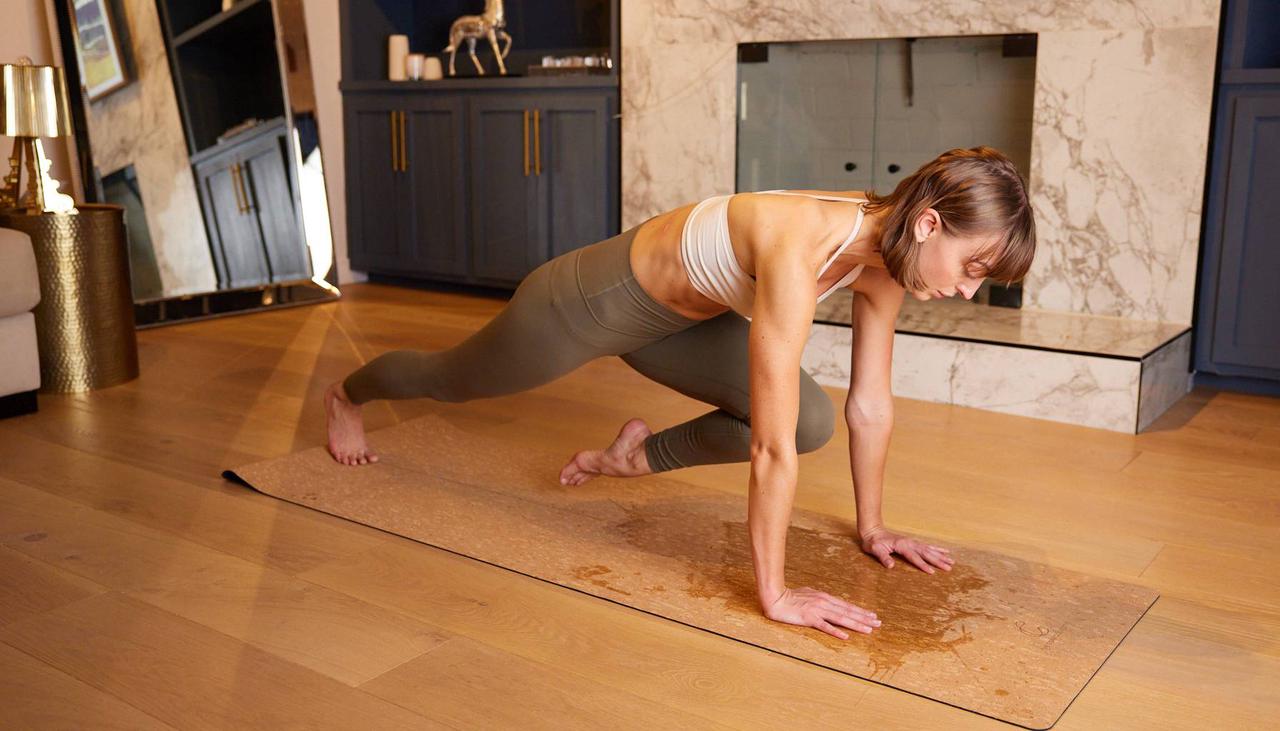Introduction
In the world of yoga, the quest for a mat that combines sustainability, comfort, and performance has led many to consider the cork yoga mat. Valued for its eco-friendly appeal and superior functionality, cork has emerged as a formidable material in the creation of high-quality yoga mats. Its unique combination of non-slip surface, resilience, and natural properties offer an intriguing alternative to traditional options. In essence, the choice of a yoga mat goes beyond mere preference; it reflects a yogi's values towards the environment and their personal practice, making the consideration of a cork yoga mat ever so pertinent.
This article delves into the benefits and potential downsides of cork yoga mats, addressing their sustainability, stability, and non-toxic nature. It also compares cork to traditional materials to illustrate why many yogis are making the switch. Maintenance and care tips are provided to ensure the longevity and preservation of cork's high quality. By examining these aspects, the article presents a comprehensive overview, enabling readers to make an informed decision on whether a cork yoga mat aligns with their yoga practice and ecological values.
Benefits of Using Cork for Yoga Mats
Natural Stickiness for Grip
Cork yoga mats are renowned for their exceptional grip, which is a crucial factor during yoga practices. The natural waxy substance in cork, known as Suberin, enhances the mat's grip, especially when it becomes wet, making it ideal for hot yoga sessions. This unique feature allows practitioners to maintain poses without slipping, providing stability and safety (123).
Firm yet Responsive Cushioning
One of the standout features of cork yoga mats is their cushioning. Cork is composed of millions of tiny air-filled cells which act as natural shock absorbers. This structure not only provides a comfortable, soft surface that relieves pressure on joints and bones but also remains firm enough to support stability during various yoga poses (24).
Antimicrobial and Odor-Resistant
The antimicrobial properties of cork are a significant benefit for yoga practitioners. Cork naturally repels bacteria, mold, and mildew, which are common issues with other types of mats. This property ensures that cork mats remain hygienic and odor-free, even with frequent use. Practitioners can enjoy a clean and healthy surface for their yoga sessions, minimizing the risk of allergies and irritations (156).
Eco-Friendly and Renewable
Cork is an eco-friendly material sourced from the bark of the Cork Oak Tree, which does not harm the tree during the harvesting process. This renewable resource also plays a crucial role in carbon sequestration, absorbing significant amounts of CO2, which helps in combating climate change. Furthermore, cork is biodegradable and recyclable, making it an excellent choice for environmentally conscious individuals (274).
Potential Downsides of Cork Yoga Mats
Cork yoga mats, while celebrated for their sustainability and natural characteristics, also present certain challenges that may influence a user's choice. These include their weight, durability under frequent use, and cost implications.
Heavier than Other Mats
Cork yoga mats are generally heavier compared to mats made from materials like PVC or rubber. This increased weight can make them less convenient to transport, particularly for individuals who travel to yoga classes by foot or public transportation (89910).
Wear and Tear with Frequent Use
Despite cork's natural durability, these mats may show quicker signs of wear and tear when used frequently. Users might notice that the surface becomes rougher and less smooth over time, which could affect the mat's grip and cushioning properties, potentially diminishing the overall yoga experience (89).
Higher Initial Cost
The initial cost of cork yoga mats is typically higher than that of conventional yoga mats. This could be a deterrent for those new to yoga or those on a strict budget. The higher price point is attributed to the sustainable harvesting and manufacturing processes involved in producing these eco-friendly mats (8911).
By considering these potential downsides—weight, durability, and cost—practitioners can better assess whether a cork yoga mat aligns with their specific needs and preferences in their yoga practice.
Why Choose Cork Over Traditional Mats
Sustainability
Cork stands out as a superior choice over traditional yoga mat materials like PVC or rubber due to its remarkable environmental benefits. Harvested sustainably from the bark of the cork oak tree, cork does not harm the tree, which continues to grow and absorb carbon dioxide, thus aiding in carbon sequestration (1213). This cycle of regeneration every 9-10 years positions cork as a highly renewable resource. Additionally, cork is completely biodegradable and compostable, contrasting sharply with synthetic mats that may spend centuries in landfills (144). By opting for cork, users contribute directly to the preservation of biodiversity in cork oak landscapes, which provide crucial habitats for endangered species (12).
Health Benefits
Cork's natural properties offer significant health advantages, making it an ideal material for yoga practitioners concerned with cleanliness and allergies. It is naturally antimicrobial and hypoallergenic, resisting the growth of bacteria, mold, and mildew (4). This makes cork yoga mats easy to maintain and ideal for yogis with sensitive skin or allergies (1415). The absence of chemical finishes further ensures that users are not exposed to harmful substances during their practice (14). Moreover, cork's natural grip enhances with moisture, providing a stable and safe surface that increases in efficacy during intense sessions, thereby supporting both the physical and mental aspects of yoga practice (1316).
Maintenance and Care Tips
Cleaning Methods
Cork yoga mats boast inherent antimicrobial properties, making them relatively easy to maintain. Regular cleaning can be achieved with a simple solution of cold water and a mild soap. It's essential to avoid abrasive products, as these can degrade the cork material more rapidly (1718). For a deeper clean, users might opt for a homemade solution of distilled water and organic white vinegar in a 4:1 ratio, adding a few drops of essential oil for fragrance. This mixture should be sprayed lightly and wiped with a soft cloth in circular motions to avoid soaking the mat (19).
For those preferring a more natural approach, a few drops of essential oils like tea tree or lavender can be added to water for their disinfecting properties. However, it is crucial to use these sparingly to prevent damage to the cork (20). After cleaning, the mat should be hung to air dry completely before storage to maintain its integrity and prevent any damage from moisture (212220).
Storage Tips
Proper storage is vital for preserving the quality of a cork yoga mat. It is recommended to roll the mat with the cork side facing outward, which helps maintain its flatness and prevents creases (1719). Storing the mat in a cool, dry place away from direct sunlight is crucial, as UV rays can degrade the cork and the natural rubber backing (19). For those who frequently use their mats outdoors or in moist conditions, ensuring the mat is completely dry before rolling it up is essential to prevent the growth of mold or mildew (2019).
By adhering to these straightforward cleaning and storage guidelines, practitioners can significantly extend the life of their cork yoga mats, ensuring they remain a hygienic and effective part of their yoga practice.
Conclusion
Throughout this discussion, we have explored the numerous advantages of cork as a material for yoga mats, highlighting its exceptional grip, cushioning, and antimicrobial properties that make it an ideal choice for yogis. The eco-friendly attributes of cork, alongside its significant health benefits, establish it not merely as a practical selection but as a reflection of a conscientious lifestyle choice. While acknowledging the downsides such as weight, wear, and cost, it becomes apparent that the benefits of cork yoga mats—ranging from their sustainability to their contribution to a healthier practice environment—greatly outweigh these concerns, making them a worthy investment for both dedicated and novice practitioners equally.
The decision to integrate cork into your yoga practice is a step towards embracing a sustainable, health-conscious lifestyle that aligns with the ethos of yoga itself. By considering cork, practitioners not only support the environment but also benefit from a superior yoga experience supported by the unique characteristics of cork. For those ready to make this beneficial switch, remember to use the Promo Code "BestCorkYogaMat" to get 15% off your next purchase, enhancing your yoga journey. As we continue to explore materials and practices that contribute to a healthier planet and personal wellbeing, the adoption of cork yoga mats stands out as an impactful choice with far-reaching benefits, inviting yogis to contribute to a more sustainable future with every pose and breath.
FAQs
-
What is the lifespan of a cork yoga mat?
Cork yoga mats are designed to endure at least 1-2 years of regular use, making them significantly more durable than most yoga mats made from materials like PVC, TPE, or rubber, which typically last about 8 months to a year. -
2. How do cork mats compare to other types of mats?
Cork mats excel in sound isolation and ease of handling, although they may not be as durable as other materials. Rubber mats are known for their superior grip and ability to dampen vibrations, producing warmer sounds akin to original recordings. Leather mats, known for enhancing bass tones, provide a luxurious feel but are generally more expensive. -
What are the best materials for yoga mats?
The optimal materials for yoga mats are generally considered to be thermoplastic elastomer (TPE) and natural rubber, due to their excellent grip, durability, and eco-friendliness. PVC (polyvinyl chloride) is also a popular choice because it is easy to clean and durable. -
Do cork yoga mats effectively absorb sweat?
Yes, cork yoga mats are non-slip, 100% sweatproof, and inherently antimicrobial, which helps to eliminate bacteria and odors effectively. Cork is not only a highly sustainable option but also offers comfort, support, and aesthetic appeal.
References
[1] - https://corcyoga.com/2023/02/21/benefits-of-a-cork-yoga-mat-over-a-traditional-yoga-mat/ [2] - https://corkspace.co.uk/pages/why-cork [3] - https://the-asanas.com/en-us/blogs/yoga-mindfulness/whybuycorkyogamat [4] - https://noveme.co.uk/blogs/stories/cork-yoga-mat [5] - https://swiftyscooters.com/blogs/journal/our-easy-tips-for-giving-your-cork-yoga-mat-a-clean [6] - https://yuneyoga.com/blogs/yoga-blog/the-eco-friendly-benefits-of-using-a-cork-yoga-mat [7] - https://zenfulyoga.ca/blogs/news/sustainability-of-cork-mats [8] - https://www.wanderingjustin.com/best-cork-yoga-mat/ [9] - https://www.quora.com/Are-cork-yoga-mats-good [10] - https://yogasanamats.com/blogs/news/guide-to-the-best-eco-friendly-yoga-mats [11] - https://www.linkedin.com/pulse/cork-yoga-mats-market-analysis-size-share-growth-q4ydc/ [12] - https://yuneyoga.com/blogs/yoga-blog/embrace-sustainability-with-a-top-quality-cork-yoga-mat [13] - https://www.zonebylydia.com/blogs/inthezone/choosing-the-right-yoga-mat [14] - https://corkhouse.com/blogs/blog/5-spectacular-benefits-of-cork-yoga-mats [15] - https://reviewed.usatoday.com/health/features/cork-yoga-mat-review-gaiam [16] - https://corkcollective.com/blogs/news/are-cork-yoga-mats-any-good [17] - https://zenfulyoga.ca/pages/caring-for-cork-yoga-mats [18] - https://yogahauslondon.com/pages/care-and-storage-instructions [19] - https://asivanayoga.com/blogs/yoga-blog/flux-cork-yoga-mat-care [20] - https://bodybyyoga.training/yoga-mats/how-to-clean-a-cork-yoga-mat/ [21] - https://www.everydayyoga.com/blogs/official/the-best-way-to-clean-care-for-a-cork-yoga-mat [22] - https://www.chuchka.com.au/blogs/news/how-to-clean-a-cork-yoga-mat-in-3-steps




Leave a comment
This site is protected by hCaptcha and the hCaptcha Privacy Policy and Terms of Service apply.